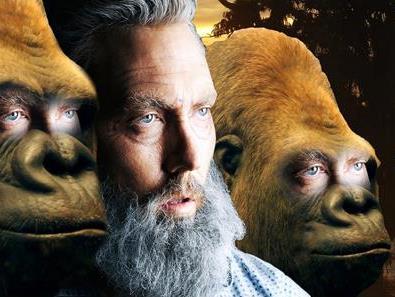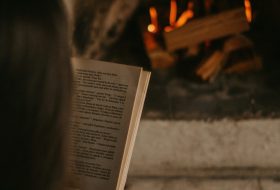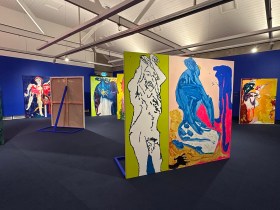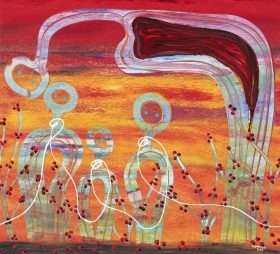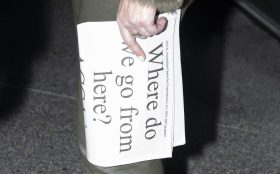Detail of TV Moore’s lightbox “Pre Fairweather Ancient Times” (2014) in his survey exhibition Rum Jungle at Campbelltown.
Regional galleries have increasingly filled a niché in presenting survey shows by mid-career artists. Such exhibitions are vital in giving the artist that platform of consideration – to consolidate, review their practice and step forward anew – but also for us as viewers to take account of the trajectory and value we have placed on the careers of Australia’s contemporary artists.
One such survey is that of TV Moore which recently opened at Campbelltown Arts Centre in Sydney’s outer West. With the title Rum Jungle we can anticipate a bit of creative anarchy and this is a gallery that has strongly nurtured its culturally diverse local community. But was this exhibition exactly what audiences expected?
‘Not my cup of tea’, said one, ‘Bloody stupid. I don’t get it,’ said another. They were comments overheard as I was viewing Moore’s show for review. Perhaps it was the confrontation of colour and density of video that define this show; or the fact that there was no way to access this show – there was no catalogue, no room texts and a floorplan that was more like a graphic design exercise that a viewing tool.
One, then, can only conclude that this was not of importance to Moore; that the exhibition was an exercise in creative self-indulgence and theatricality. The only hint one has was an introductory blurb that warned viewers they would be ‘immersed in an inebriating environment’.
Punch drunk or queasy, this exhibition has a retinal burn that is hard to shake. The pressing question remains with time: does the colour-scheme overwhelm the art?
The first work visitors encountered was a kinetic sculpture with two lurching mounted monitors; the actual video content taking second place to the experience of watching. It signaled to audiences that this was an exhibition that need not be watched or even understood; it was about inverting expectations.

While I might argue that this was one of the more resolved pieces in the exhibition, I am still not convinced that its instruction transpired across the exhibition and carried the viewer on a journey of discovering who TV Moore is?
The central gallery presented a run of small framed works from Moore’s most recent Rum Jungle Series that sat like tiny jewels on lurid yellow walls. Their presentation was clearly deeply considered, and while these are some of Moore’s most engaging works, they have been pawned for paint, the colour snuffing the energy from these works, spatially lost.

In contrast Moore’s work from the same series currently on show at the Museum of Contemporary Art Australia (MCA) for the 19th Biennale of Sydney, are presented against a white tile wall; their more imposing scale offering a strong conversation of surface and content. Having seen both the contrast is dramatic and illustrates how important exhibition design can be.
Back in Campbelltown standing in the gallery, sound bleeds come from everywhere, vying and tugging for your attention. Sensorial confusion is implanted.
To the left of the central gallery Moore set up a kind of experiential polarity. In the largest gallery a single floating screen presented Moore’s Tripasso in Wackyland (2014), a 1930s-style cartoon animation over random TV footage against an orchestral backdrop.

Painted and carpeted “piss yellow”, the colour again dominated the artwork, leaving the viewer to ask whether it was spatially excessive, warranted? One can guess that the intention was to extend the “character” of the film to immerse the viewer, but when you place a single channel work in the room of this scale you expect it to snatch and hold and draw in the viewer. It fell flat.
An adjacent smaller gallery, in contrast, overloaded one with stimuli, stacked screens and monitors facing off in a collection of his video works from 1999 to 2009. Moore has consistently used performance and non-narrative structures, music and theatrical staging and lighting effects within his work, and in this compendium of videos you start to get a feel for the kind of psychological space and histories that underlie Moore’s work. It is the one room where things started to make sense.
Moving across the gallery you come to a sequence of rooms. In a stand-alone corner, presented on key-lime green walls, is the video installation What Say U Wii? (2009). Dressed up as a “dood” Moore is lip-syncing a boy describing his favourite video games.

Moore takes on two further personas in this exhibition. Two lightboxs – both presented at floor level – are titled after the celebrated painter Ian Fairweather: Darwin Fairweather Baby & Me (2014) and Pre Fairweather Ancient Aliens (2014). Known for his hermit lifestyle on Queensland’s Bribie Island, and raft journey to Darwin, one wonders what Moore is channeling through these works?

Writer Andrew Frost described Moore’s art as ‘a clever kind of ventriloquism, a voice self-consciously in search of authenticity’. While Fairweather was the “real thing” when it comes to the artist, I think a greater truth for Moore was revealed in the final work in this survey, tucked away in a back corner and void of the bravado of scale and colour.
Extending this psychological portrait, Moore’s The Forgotten Man (2006) is a faux period documentary of vagrants in Sydney, all characters played by the artist. Listening for a while you start to suspect this is where the message of this exhibition lies – hidden deep within its heart – a parallel journey of isolation, rejection and self-doubt. It is more raw than any jarring video or collage of appropriated images.

Overall, Moore’s intentions remain unclear across this exhibition. It is without doubt a deeply considered survey of the past fifteen years of his practice, however, its staging is it too manufactured that it isolates the viewer from the work.
Rating: 3 out of 5
TV Moore’s Rum Jungle is showing until 25 May
Campbelltown Arts Centre, NSW
